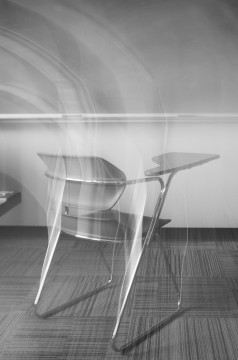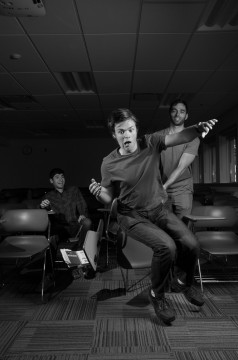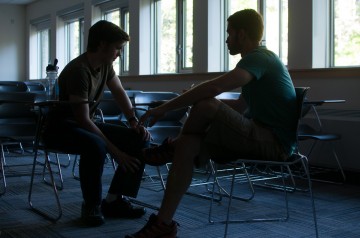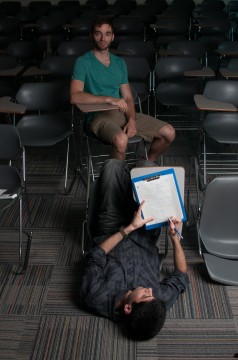In early July, I shot a cover photo for the latest Martlet feature on “flipping the classroom,” a teaching method that asks students to do homework during lecture time and absorb the lecture material at home through videos or assigned reading. It was a photo assignment dear to my heart, since I wrote the feature myself. Early on in the writing process, I imagined someone flipping over a desk, to the shock of the students sitting in them, books and pencils flung about à la Dali Atomicus, the famous picture of Salvador Dali. However, this proved to be a logistical nightmare, because the university does not have separate desks and chairs in their classrooms — only tablet-arm desks or large lab benches, neither of which can flip easily. After days of phone calls, I had no choice but to adapt my concept to the available furniture, which in this case was the tablet-arm desks.
As the desk could not flip independently of the chair, I had to adapt. I asked my model to dive out of the chair as the entire assembly was flipped. It seemed fun, but I could already feel that it was a little off. After a few attempts, one of the models (and an interview subject) expressed some concern over the concept, as it wasn’t really what he had in mind. I began to feel the blood pulsing behind my eyeballs.
I sometimes flashback to my days as a classical pianist, when I would be in the middle of a concert and I’d simply forget where my fingers were supposed to land next. The plan, of course, was to practice until the individual finger movements dissolved into a single swooping motion with movements so rehearsed that my hands slid over the keys of their own accord, transcending the need to walk from note to note. If the movements weren’t as rehearsed, I’d hear the dissonance, and recovery was never assured.
If a performance ever broke down, there would be a deafening silence as the audience sat in confusion. My piano teacher would bite her fingernails and wait, counting the seconds until I found my bearings. If I did, it would be a rapturous occasion, and I could literally hear a collective exhale from the crowd. I wasn’t quite there yet.
I asked my subjects if I could have a minute to think of something new.
I tentatively turned the flashes off and made simple snaps of my subjects working out a math problem, like making a few weak improvisations on the piano to remind me of the next phrase. Sometimes that would work, but in this case, it didn’t. Then, like my teacher calling out the next note from the audience, one of my subjects suggested I just turn one of the tab desks upside down. It was a kernel of an idea, and it was just what I needed.
I thought back to a photo I shot last year, a reflection image of a light bulb. I just slotted a student into the upside down seat, and had the instructor sit right side up. The student held an iClicker, a response tool mentioned in the article, as well as his notebook. In a few minutes, it was all over. I heard the collective exhale.
Camera: Nikon D300, 35mm f/1.8 DX @ f/5.6, 1/160 sec, ISO 400.
Light: Nikon SB-800 through 60” umbrella at camera right.













